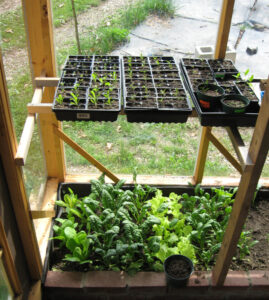- Like
- Digg
- Del
- Tumblr
- VKontakte
- Buffer
- Love This
- Odnoklassniki
- Meneame
- Blogger
- Amazon
- Yahoo Mail
- Gmail
- AOL
- Newsvine
- HackerNews
- Evernote
- MySpace
- Mail.ru
- Viadeo
- Line
- Comments
- Yummly
- SMS
- Viber
- Telegram
- Subscribe
- Skype
- Facebook Messenger
- Kakao
- LiveJournal
- Yammer
- Edgar
- Fintel
- Mix
- Instapaper
- Copy Link
A version of this column first ran in the Roane County (WV) Reporter and Times Record. Support local journalism! Subscribe to your local newspaper. This is one of a series of blogs for new gardeners. Start reading the whole series here: Part 1.
Season extension refers to ways of growing things later into fall after a frost, or starting earlier in spring. It’s still summer now, but if you want to be able to harvest crops in November and December—or to get started in February next year—it’s not too early to contemplate some ways of protecting vegetables from winter.
We’ll start with the easiest, cheapest, and lightest kind of protection—putting a fabric cover over a row. It’s best to have a support of some kind, rather than just draping the fabric right over the plants—which lets cold and wet right up against the plants, potentially “burning” the leaves, and may also mash down and deform plants. The frames that promotional yard signs are mounted on make great supports, but any kind of wire, bent into a hoop (or in a square as the yard sign supports are) will work. There is a kind of light spun fabric, which includes the stuff called Ree-may, which is specifically designed for this—you can buy it in various weights (the lightest will keep bugs off but doesn’t do much to keep heat in).
My neighbor has a version of this approach in which he leans rows of glass panes against each other, taped at the top, to form a triangular tunnel. This works well to protect spinach, lettuce, kale, or mustard all winter.
The next step up from row cover is a cold frame. This is a box, usually made of wood, with a window for the top and no bottom. It may be built against a house or other structure, with the building as its back (north) wall—or it may be free standing. But the top slants downward to maximize low angled sunshine coming in: the wall on the south side is several inches lower than the wall at the back. The top needs to be hinged so it can be opened a few inches on warm days, lest the vegetables cook.
Cold frames are mostly used for starting seedlings in spring, or for hardening them off before setting them out in the open garden. But they can also house semi-hardy vegetables through winter.
More serious protection comes from a greenhouse—and here there are endless possibilities. You can buy kits for little portable greenhouses with plastic covers. You can also buy bigger, more durable (and expensive) greenhouse kits. Or you can build your own, which is what we did, putting an attached greenhouse against the south wall of our house. This greenhouse has proven very useful, not only for starting seedlings in spring (and now) but for other uses: I dry towels on the shelves near the south wall, I dry beans and sunflower heads and peanuts there, and it can move enough warm air into the house on a cold sunny day to make the difference where we don’t need a fire. It once raised four chicks from eleven days old—when some evildoer killed their mother—until they were about three months old, ready to join the flock. That also gave us quite a window into chick development.
The final and most serious option is a high tunnel. Some people even put heaters and ventilation in these. A downside of a major greenhouse of this sort is that you have to irrigate all the time, as of course rain can’t get in. I’ve noticed that plants in high tunnels have a lot less disease problems, too…but I think insects can be worse than outside. There may be grants available for high tunnels—ask your local extension agent or check with the USDA.
The first year I had my greenhouse, I planted lettuce and spinach in a bed on the ground, on January 7th. They grew very slowly at first, but I was harvesting nice salads about the time I was planting these things in the outside garden. However, since then most of what I’ve tried planting on the ground bed is destroyed by some tiny bugs. Whatever it is does not bother what I set on the shelves a few feet up. Once I tried capturing a dozen Asian lady beetles and putting them in there; within a couple of days, my lettuce and spinach plants looked much better. But then a cold night killed the beetles, but not the pest bugs (aphids?)—so now I keep saying I’ll do some kind of covered bed in my garden instead. Last year I set a window on a frame of bagged hay, over some chard plants, which came through the winter nicely.
This year, I’m trying the fabric over wires scheme; I’ve planted lettuce and radishes under one set of three yard-sign wire frames, and spinach and radishes under the other. I won’t need to cover it until November.
Read the rest: Part 1. Part 2. Part 3. Part 4. Part 5. Part 6. Part 7. Part 8. Part 9. Part 10. Part 11. Part 12. Part 13. Part 14. Part 15. Part 16. Part 17. Part 18. Part 19. Part 20.













